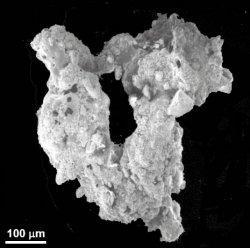Today, the majority of Apollo samples are stowed in a vault at Johnson Space Center, in Houston, behind the same kind of door one might find inside Federal Reserve banks in major U.S. cities, according to a NASA spokesperson. Curators loan them out to scientists around the world in small helpings. Soon, a special trove of samples will emerge from the vault. Scientists set them aside in the early 1970s. They hoped that someday other researchers would come along, with the same interest in Earth’s silvery companion, but better instruments.
In the next year, Sehlke, along with other scientists and their teams, will receive tiny lunar samples, untouched for close to 50 years, that were collected during the Apollo 15, 16, and 17 missions. Some were frozen or stored in helium-filled containers shortly after arriving on Earth. One sample has never been exposed to Earth’s atmosphere; it was packed and vacuum-sealed on the moon by the last astronauts to walk on the surface, in 1972. Sehlke and other researchers still have many questions about the workings of the moon—even about the popular hypothesis for its creation, which doesn’t completely add up—and searching for answers within these pristine samples is a thrilling prospect.
“I fully expect that we’re going to find some pretty exciting and profound new things about these samples,” says Darby Dyar, an astronomy professor at Mount Holyoke College, and one of the scientists who will receive a batch of both vacuum-sealed and helium-stored soil.
Dyar has worked with lunar samples since 1979, when she was pursuing her doctoral degree in geochemistry. All had been exposed to the atmosphere before reaching her. In addition to potentially offering new surprises, the unspoiled samples could help her fact-check what she’s observed so far. “We’d like to be sure that what we’ve observed in the lunar samples is indeed a product of the way they were on the moon, and not something that was changed in them once they were exposed to air,” she says.
Dyar is interested in microscopic by-products of the moon’s molten youth, when the surface erupted in volcanoes. The explosions spewed lava high above the surface, where temperatures were dramatically cooler. By the time the splatter fell back down, it had cooled into tiny beads of glass. The beads contain a record of the interior of the moon, another mystery yet to be solved.
“In those days, we didn’t have technology that could look at things at a microscopic scale very well,” she says. She had to grind up already small samples to get a close look. But she’s ready now; she has spent years refining the technique for closely examining these little volcanic orbs, with microscope technology capable of examining nanometer-scale features. “This is exactly the technology that they were waiting on,” she says.
Only by geological circumstance have scientists managed to excavate—and may do so again—significant information about the history of the moon from such minuscule sources. The Apollo samples are not representative of the moon; they came from just six spots on the near side. But unlike Earth, the surface of the moon has remained mostly unchanged over billions of years. It is a geologist’s dream, and our planet is the nightmare.
“We have liquid water on our planet, which, from a geology standpoint, really sucks,” says Juliane Gross, an Earth and planetary scientist at Rutgers University. “We have rain and wind, and it degrades rocks and turns them into soil, and then transports them into the ocean. And then we have plate tectonics—it’s even worse.”
If extraterrestrial geologists landed outside of Gross’s office in New Jersey and scooped up some dirt, their knowledge of the planet would extend only a few million years into the past. The moon, free of weather and shifting ground, keeps better records. “The crust represents this archive of information, and all we need to do is learn how to read this archive and interpret it correctly,” Gross says.
Scientists hope the archive will expand someday, with new missions to the moon. The Trump administration wants to return Americans to the surface in 2024, an ambitious plan considering budget constraints, but the destination certainly is tantalizing: the south pole, where a massive impact carved a crater deep enough to expose potentially intriguing bits of the lunar crust.
Until the next trip, NASA will reach into the vault. Curators must carefully remove the sealed samples and prepare them for shipment to the eager scientists. A NASA spokesperson would not disclose delivery details, citing security concerns, but researchers say they have received other lunar samples by mail, in small packages. Incredibly, they haven’t included fragile stickers. Sehlke wondered whether he shouldn’t just drive down to Houston and pick up the samples himself; no offense to the post office, but this is precious cargo. He worries the package will pass through an X-ray machine in a shipping center somewhere, an experience that could alter the radiation signatures within the samples that he’s hoping to detect.
When they arrive, Sehlke will analyze his haul—less than a teaspoon of material—at his lab at NASA’s Ames Research Center, in California; it will be tinged with red light to protect the properties of the delicate samples.The geologist will expose the grains to scorching temperatures, which will cause them to emit light. By examining that little glow, scientists can decipher the effects of sun exposure on the lunar soil over cosmic timescales. “We can reconstruct the past of the moon in terms of its temperature,” Sehlke says.
Sehlke, who was born in the 1980s, well after the moon landings, says geologists conducted similar experiments on samples decades ago. But as his predecessors predicted, he has better technology now. And he’s grateful they saved some for him.
Quelle: The Atlantic


